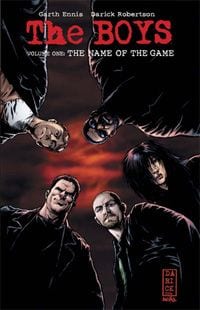
It’s sad — but true — that graphic fiction such as Alan Moore’s Watchmen comes around only every so often (usually when Moore decides to put pen to paper). And, fair or not, comic book reviewers still insist on comparing the newest comics out there to Moore’s distinguished masterpieces.
Honestly, I’m no different. It’s understandable. When someone excels in their field the way Moore does and consistently sets new standards, every other writer has to expect a comparison or two.
And it doesn’t make it any less conspicuous when an author (either purposefully or unwittingly) directly addresses a questioned posed by Moore in one of his writings.
“Who watches the watchmen?” Moore asks in some graphic novel you might have heard of. Well, according to Garth Ennis, The Boys do.
Now, understand, Ennis himself is no slouch. He’s brought us some great pieces, including his much-acclaimed Preacher series, Bloody Mary, and a well-remembered stint on Hellblazer. So, it’s an exciting prospect when he undertakes a story that dozens of other writers have attempted.
But, because I’ve already committed myself to the obligatory Moore comparison, think of it this way: The Boys is to Watchmen what the Incredible Hulk is to Bruce Banner.
Ennis’ tale is a little more blunt and in-your-face. It’s in the same vein as Moore’s story, but it really doesn’t offer as much cultural or societal value — and it definitely isn’t as smart.
But it sure as hell kicks a lot of ass (and yes, it has been the cause of some damage control).
Originally published by Wildstorm, but dropped due to “content concerns,” The Boys tells the tale of a CIA-operated super human team that keeps an eye on the established heroes and villains, all of whom seem to have their own deep, dark secrets.
But The Boys don’t mind getting down and dirty, themselves. Currently in its 18th issue after being picked up by Dynamite comics, Ennis said he expects this series to run about 60 issues and wants to “out-Preacher Preacher.” And artist Darick Robertson (Transmetropolitan) has absolutely no qualms illustrating Ennis’ wish to all its bloody, sex-filled fruition.
“I used to run a team had the job of stopping’ the sort of s–t that happened to Robin,” Boys leader, Butcher, explains to prospective team member Wee Hughie who has just witnessed his girlfriend’s accidental decapitation by an errant speedster superhero. “Or if we couldn’t stop it, we made sure the guilty party was in no condition to do it again . . . The supes, we were the ones who kept an eye on ’em.”
“Superheroes . . . ?” Wee Hughie asks.
“Yeah, you know. The long underwear brigade. Treat the world like their f—in’ playground,” Butcher replies.
And if the absence of lost love between The Boys and superheroes lacks any semblance of subtleness, it’s only because it parallels Ennis’ writing tastes, which lean toward grittier, darker material, rather than the lighter, more flamboyant costumed creations. Rumor has it the anti-superhero sentiment actually might have been one of the reasons The Boys was dropped by Wildstorm (a DC imprint).
But, like many of his other stories, Ennis uses The Boys as a vehicle for cultural commentary. A reoccurring theme throughout the first two story arcs is the disconnect between American and European culture (Butcher, a Brit, constantly refers to Americans as “septics.” And when Wee Hughie — a Scot — asks him how he can work for the CIA, he replies, “You shake hands with the Devil, but you do a bit of good. You maybe save a few lives.”)
Also up for discussion throughout the series are the dissolution of childlike naiveté (a new female recruit for the world’s premier superhero team, The Seven, is commanded to service three of the male members); scientists playing god with DNA tampering; the persecution of gay culture; and, yes, even sexual fetishism.
“Doctor,” superhero Tek-Knight admits to his therapist in the first panel of the second story arc, “I can’t stop f—ing things.”
If it sounds ridiculous, that’s because it is. The two craziest members of The Boys play reverse-strip poker (putting clothes on when they lose). In Russia, The Boys set up shop with a retired superhero named Love Sausage (for obvious reasons) who hooks Wee Hughie on vodka made from brake fluid, and at one point Butcher commands his bull dog, Terror, to anally infiltrate an obnoxious Pomeranian in order to cheer up Wee Hughie.
Complementary to Ennis’ writing is Robertson’s illustration. His dark and less-polished style contributes to the overall somber depiction of the world The Boys inhabit. Later in the second story arc, “Get Some,” Peter Snejbjerg jumps aboard from some illustration. His art, which can gravitate toward an almost Crumb-like style, is perfect for some of the more over-the-top scenes.
So, while it’s no Watchmen (come on, nothing is), it’s still been a pretty impressive run thus far — definitely one of Ennis’ better series. And as far as government-organized superhero watchdogs go, The Boys are way ahead of anyone else in the game (I’m looking at you S.H.I.E.L.D.).

![Call for Papers: All Things Reconsidered [MUSIC] May-August 2024](https://www.popmatters.com/wp-content/uploads/2024/04/all-things-reconsidered-call-music-may-2024-720x380.jpg)



